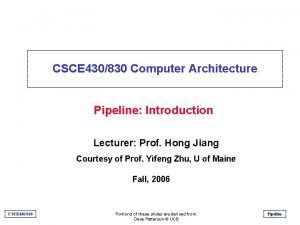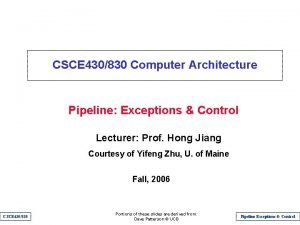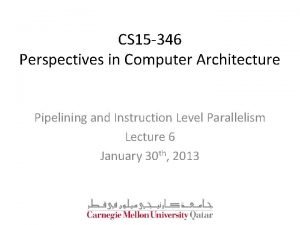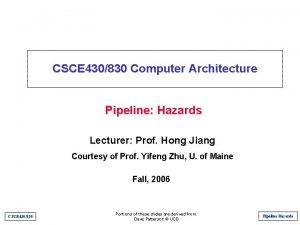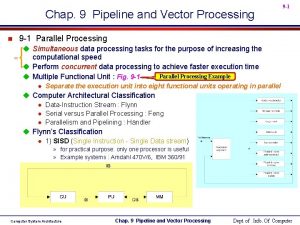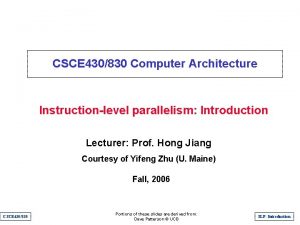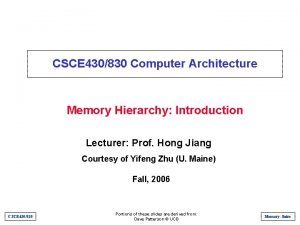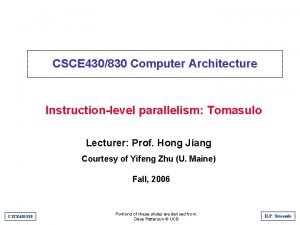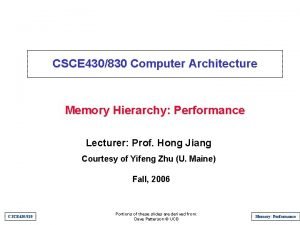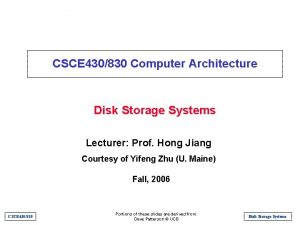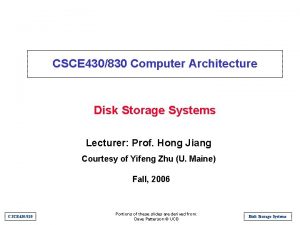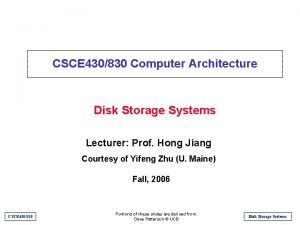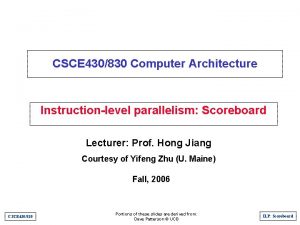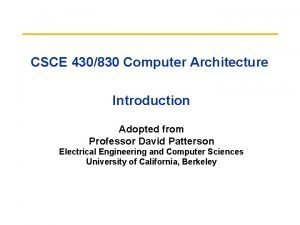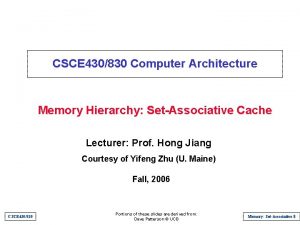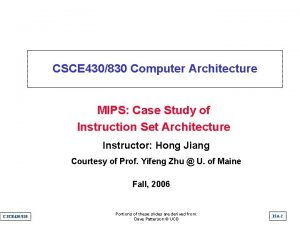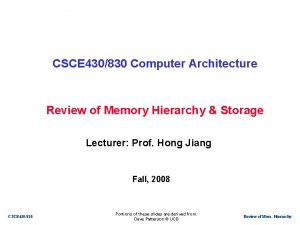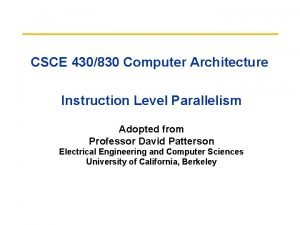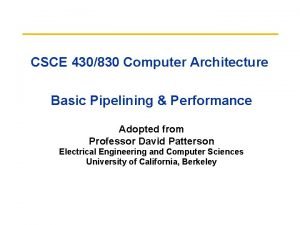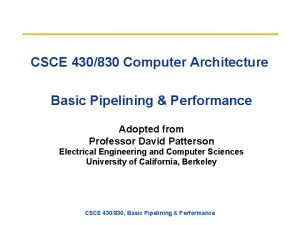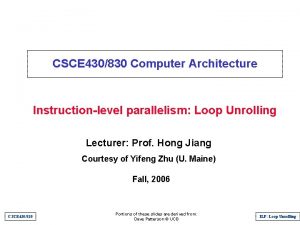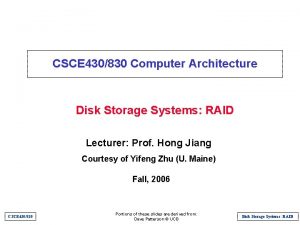CSCE 430830 Computer Architecture Pipeline Introduction Lecturer Prof


























- Slides: 26

CSCE 430/830 Computer Architecture Pipeline: Introduction Lecturer: Prof. Hong Jiang Courtesy of Prof. Yifeng Zhu, U of Maine Fall, 2006 CSCE 430/830 Portions of these slides are derived from: Dave Patterson © UCB Pipeline

Pipelining Outline • Introduction – Defining Pipelining – Pipelining Instructions • Hazards – Structural hazards – Data Hazards – Control Hazards • Performance • Controller implementation CSCE 430/830 Pipeline

What is Pipelining? • A way of speeding up execution of instructions • Key idea: overlap execution of multiple instructions CSCE 430/830 Pipeline

The Laundry Analogy • Ann, Brian, Cathy, Dave each have one load of clothes to wash, dry, and fold A B C D • Washer takes 30 minutes • Dryer takes 30 minutes • “Folder” takes 30 minutes • “Stasher” takes 30 minutes to put clothes into drawers CSCE 430/830 Pipeline

If we do laundry sequentially. . . 6 PM T a s k A O r d e r C 7 8 9 10 11 12 1 2 AM 30 30 30 30 Time B D • Time Required: 8 hours for 4 loads CSCE 430/830 Pipeline

To Pipeline, We Overlap Tasks 6 PM 7 8 9 10 30 30 T a s k A O r d e r C 11 12 1 2 AM Time B D • Time Required: 3. 5 Hours for 4 Loads CSCE 430/830 Pipeline

To Pipeline, We Overlap Tasks 6 PM 7 8 9 30 30 T a s k A O r d e r C B D CSCE 430/830 10 11 12 1 2 AM Time • Pipelining doesn’t help latency of single task, it helps throughput of entire workload • Pipeline rate limited by slowest pipeline stage • Multiple tasks operating simultaneously • Potential speedup = Number pipe stages • Unbalanced lengths of pipe stages reduces speedup • Time to “fill” pipeline and time to “drain” it reduces speedup Pipeline

Pipelining a Digital System 1 nanosecond = 10^-9 second 1 picosecond = 10^-12 second • Key idea: break big computation up into pieces 1 ns • Separate each piece with a pipeline register 200 ps 200 ps Pipeline Register CSCE 430/830 Pipeline

Pipelining a Digital System • Why do this? Because it's faster for repeated computations Non-pipelined: 1 operation finishes every 1 ns Pipelined: 1 operation finishes every 200 ps CSCE 430/830 200 ps Pipeline

Comments about pipelining • Pipelining increases throughput, but not latency – Answer available every 200 ps, BUT – A single computation still takes 1 ns • Limitations: – Computations must be divisible into stage size – Pipeline registers add overhead CSCE 430/830 Pipeline

Pipelining a Processor • Recall the 5 steps in instruction execution: 1. 2. 3. 4. 5. • Instruction Fetch (IF) Instruction Decode and Register Read (ID) Execution operation or calculate address (EX) Memory access (MEM) Write result into register (WB) Review: Single-Cycle Processor – All 5 steps done in a single clock cycle – Dedicated hardware required for each step CSCE 430/830 Pipeline

Review - Single-Cycle Processor CSCE 430/830 • What do we need to add to actually split the datapath into stages? Pipeline

The Basic Pipeline For MIPS Reg DMem Reg ALU Ifetch DMem ALU O r d e r Reg ALU I n s t r. Ifetch ALU Cycle 1 Cycle 2 Cycle 3 Cycle 4 Cycle 5 Cycle 6 Cycle 7 Ifetch Reg Reg DMem Reg What do we need to add to actually split the datapath into stages? CSCE 430/830 Pipeline

Basic Pipelined Processor CSCE 430/830 Pipeline

Pipeline example: lw IF CSCE 430/830 Pipeline

Pipeline example: lw ID CSCE 430/830 Pipeline

Pipeline example: lw EX CSCE 430/830 Pipeline

Pipeline example: lw MEM CSCE 430/830 Pipeline

Pipeline example: lw WB Can you find a problem? CSCE 430/830 Pipeline

Basic Pipelined Processor (Corrected) CSCE 430/830 Pipeline

Single-Cycle vs. Pipelined Execution Non-Pipelined CSCE 430/830 Pipeline

Speedup • Consider the unpipelined processor introduced previously. Assume that it has a 1 ns clock cycle and it uses 4 cycles for ALU operations and branches, and 5 cycles for memory operations, assume that the relative frequencies of these operations are 40%, 20%, and 40%, respectively. Suppose that due to clock skew and setup, pipelining the processor adds 0. 2 ns of overhead to the clock. Ignoring any latency impact, how much speedup in the instruction execution rate will we gain from a pipeline? Average instruction execution time = 1 ns * ((40% + 20%)*4 + 40%*5) = 4. 4 ns Speedup from pipeline = Average instruction time unpiplined/Average instruction time pipelined = 4. 4 ns/1. 2 ns = 3. 7 CSCE 430/830 Pipeline

Comments about Pipelining • The good news – Multiple instructions are being processed at same time – This works because stages are isolated by registers – Best case speedup of N • The bad news – Instructions interfere with each other - hazards » Example: different instructions may need the same piece of hardware (e. g. , memory) in same clock cycle » Example: instruction may require a result produced by an earlier instruction that is not yet complete CSCE 430/830 Pipeline

Pipeline Hazards • Limits to pipelining: Hazards prevent next instruction from executing during its designated clock cycle – Structural hazards: two different instructions use same h/w in same cycle – Data hazards: Instruction depends on result of prior instruction still in the pipeline – Control hazards: Pipelining of branches & other instructions that change the PC CSCE 430/830 Pipeline

Summary - Pipelining Overview • Pipelining increase throughput (but not latency) • Hazards limit performance – Structural hazards – Control hazards – Data hazards CSCE 430/830 Pipeline

Pipelining Outline • Introduction – Defining Pipelining – Pipelining Instructions • Hazards – Structural hazards – Data Hazards – Control Hazards • Performance • Controller implementation CSCE 430/830 Pipeline
 Lecturer's name
Lecturer's name Csce 430
Csce 430 430830
430830 430830
430830 Linear pipeline processor
Linear pipeline processor Pipelining in computer architecture examples
Pipelining in computer architecture examples Pipeline control hazard
Pipeline control hazard Pipeline processing in computer architecture
Pipeline processing in computer architecture Pipeline processing in computer architecture
Pipeline processing in computer architecture Paralleism
Paralleism Physician associate lecturer
Physician associate lecturer Spe distinguished lecturer
Spe distinguished lecturer Good afternoon student
Good afternoon student Photography lecturer
Photography lecturer Lecturer in charge
Lecturer in charge Designation lecturer
Designation lecturer Designation of lecturer
Designation of lecturer Guest lecturer in geography
Guest lecturer in geography Lecturer name
Lecturer name Pearson lecturer resources
Pearson lecturer resources 140000/120
140000/120 Lector vs lecturer
Lector vs lecturer Lecturer in charge
Lecturer in charge Cfa lecturer handbook
Cfa lecturer handbook Lecturer asad ali
Lecturer asad ali Bus architecture in computer architecture
Bus architecture in computer architecture Difference between computer organisation and architecture
Difference between computer organisation and architecture

